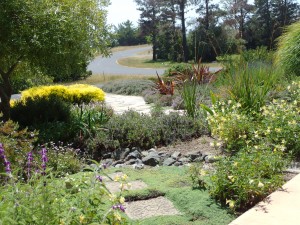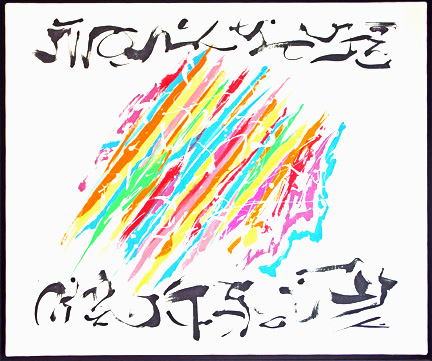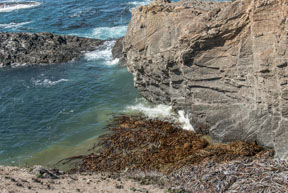Archive for the ‘writing’ Category
Doing by Not Doing
I thought I was retired from running the Mendocino Coast Writers Conference. But life happens, and so do medical crises. So I’m back as Acting Executive Director, scrambling to pick up the threads of all the detailed tasks that make up a successful conference and continue weaving them into a sweetly patterned braid.
I’ve done it before, several years of befores. My challenge is to keep calm, level-headed, unstressed. I know that to do my job well, I need to take time to do nothing.
This morning Tony and I took one of our favorite walks: from Laguna Point at MacKerricher State Park south along the cliff edge to Virgin Creek Beach, then footprints on smooth wet sand to where the water of Virgin Creek ripples and glitters as it crosses the beach to the sea. There we leave the beach and, picking up our pace, take the weather-beaten old haul road back to the Laguna Point parking lot.
This afternoon as I sit on my front porch, a white-crowned sparrow is singing from a nearby bush. Hummingbirds are working over the purple Mexican sage and yellow sticky monkey flower in front of me. I hear chirps from newly hatched Stellar’s jay chicks as a parent flies in to their nest in the wisteria vine. A violet-green swallow has come and gone from the porch corner cavity where they’ve sometimes nested. Two stems of dry grass dangle from the cavity. Not a good place this year. I warn them in my mind to beware the predatory jays.
Inspired by a talk a year or two back by Lewis Richmond, author of Aging as a Spiritual Practice, I am learning to meditate. It’s hard to push away the clutter of to-do lists, but I think I am making progress.
The mission of the Mendocino Coast Writers Conference is to offer a place where writers find encouragement, expertise and inspiration. As executive director, my encouragement comes from the support and expertise of a wonderful team of volunteers, some of whom have been helping to run the conference for nearly all of its twenty-five years. My inspiration comes from the beauty of the pattern I braid from all these threads of tasks in my hand, its colors imbued with the memory of sea and headland, forest and garden, its thread tension even, unmarred by crises.
For the sake of all the writers who leave Mendocino Coast Writers Conference inspired by the supportive atmosphere the conference team creates, I can do this.
Given Time
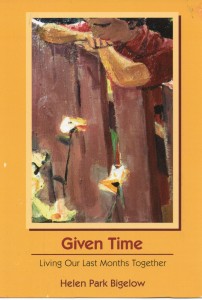 Given Time: Living Our Last Months Together by Helen Park Bigelow, which I’ve just finished reading, is an unflinching look at the emotional and physical landscape a care-giving spouse or partner must traverse in those last months before death. Helen’s husband Ed had a melanoma removed in 2005. The surgery seemed successful, and regular follow-up tests and scans at first came out clear. But three years later the melanoma returned and metastasized throughout his body.
Given Time: Living Our Last Months Together by Helen Park Bigelow, which I’ve just finished reading, is an unflinching look at the emotional and physical landscape a care-giving spouse or partner must traverse in those last months before death. Helen’s husband Ed had a melanoma removed in 2005. The surgery seemed successful, and regular follow-up tests and scans at first came out clear. But three years later the melanoma returned and metastasized throughout his body.
To offer a flavor of the book, I can’t do better than to quote the blurb by Fithian Press, the book’s publisher: “The book deals honestly with the process of dying, an ordeal shared by both of them. It also deals with the process of staying alive and in love until the ordeal is over… [Bigelow] writes with brutal honesty about her anger and grief over what has become of her husband and herself. The book isn’t a manual about how to take care of a dying man, but it makes the reader well aware of what a grueling job it is. “So this is it,” she writes. ‘This chemo routine is the rest of our lives together…and goddamn it, it’s going to be as good for both of us as I can make it.’ ”
Reading this book set me to thinking about my husband’s and my circle of friends. We’re all of an age where we’re facing mortality, both our own and our partners’. Physical infirmities creep up on us. Memories start to fail. The mechanisms of the heart become clogged. I know we’ll all do what we have to do, to the best of our abilities, when loved ones need our care, and that, if we are the ones whose lives are ending, we hope to have someone as caring as Helen to tend our passage. I’m grateful that services such as hospice are available. Most of all, I am inspired by Helen’s love of beauty to seek it out in my own life. Whether my time is counted in decades or years or even months, I want every day to be touched by grace.
A Little House for Poetry
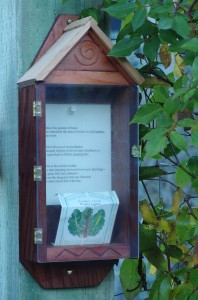 The idea came from an article in the Sept.-Oct. 2013 issue of Poets & Writers Magazine about a project to erect small installations, called poetry boxes, in public places. Their purpose, according to the artist, is to “connect people to landscape by combining poetry, visual art, and nature observation.”
The idea came from an article in the Sept.-Oct. 2013 issue of Poets & Writers Magazine about a project to erect small installations, called poetry boxes, in public places. Their purpose, according to the artist, is to “connect people to landscape by combining poetry, visual art, and nature observation.”
I decided to design a poetry box for myself. A simple little house, with just a touch of decoration: a carved spiral to symbolize the continuity of life, and a line of chevrons to signify water. I have no skill at woodwork, but my husband Tony does, and he readily agreed to take my plan and build it.
Here it is, mounted on the 6” x 6” gatepost of my fenced vegetable garden. The laminated text is thumbtacked to the back of the box, so that I can change it whenever I want to. For its debut, I placed an empty seed packet on the floor of the house and pinned up a few lines from my poem “Winter Greens,” which is published in my collection Rogue Wave at Glass Beach.
This is the gesture of hope:
to remember the taste of fresh-cut salad greens
and act on it.
This is the act of reconciliation:
muscle rhythm of shovel and wheelbarrow,
load upon load to fill the planting box.
This is the sound of faith:
a rake tamping down soil over new plantings—
snap peas, bok choi, lettuces—
tines on the diagonal, first one direction
then crisscrossed down the line.
Canticle for the Winter Solstice
I plan to read this poem at tonight’s Solstice event at Gallery Bookshop in Mendocino. Obviously it was written in a year other than 2013. We’ve had no rain all month, and none in the extended forecast, so face the likelihood of a drought year. I think of this piece as a kind of prayer.
Canticle for the Winter Solstice
I honor the rain that plummets from a leaden sky
on this day when the dying sun returns to life.
I honor the wet earth where fungi lift
the smells and secrets of their darkness
into forms potent with wildness
and fallen leaves grow slimy with decay.
I honor the sudden green suffusing
the face of the sun-scorched hill,
like the blush of knowledge in a woman’s face
after her first coupling.
I honor the flame of candle and hearth
that draws to itself the breaths
of all whose lives have sometime crossed,
mingles and transmutes them into warmth
and sends them out into the rain
where they caress the tender growing tips of trees.
Texts
Searoad, a story collection by Ursula K. LeGuin, has a permanent place on my bedside table. It’s there because every now and then I need to reread a certain story. A very short story, less than three pages, it is titled “Texts,” and tells of an older woman who, bombarded by messages and calls to action, retreats to the coastal Oregon village of Klatsand for a month-long winter break. As she walks on the deserted beach, she notices that the waves have left messages in the lines of foam, messages she can almost decipher. The laciness of the foam leads her to speculate that crochet work and lace might also be legible. In a handmade lace collar she reads a message that seems directed to her: “my soul must go, my soul must go … sister, sister, light the light.” There the story ends, with the woman not knowing “what she was to do, or how she was to do it.”
I think of this oddly moving little story every time I walk on Ten Mile Beach, as I did last Sunday. The receding waves left undulating lines of bubbles, iridescent in the hazy sunlight, that popped to form patterns of foam. Scattered across the beach were strands of bull kelp, dried into coils and loops that lay like a cursive script on the sand.
Yesterday, when the wind was brisk and the sea streaked with white caps, I remembered an interview I did for the Mendocino Art Center magazine. It was part of a series I wrote on artists who helped found the art center in the 1960s. By the time I met Jim Bertram in the early 2000s, he was senile and nonverbal, so I had to rely on material in the art center archives for information about his background and artistic vision. Nevertheless, Jim and I spent a wonderful afternoon together. I think a poem I wrote at the time sums it up:
MESSAGES
For JB
“Line expresses the inner thought. It is a narrative of what we really want to tell each other but somehow can’t seem to verbalize.”
– Jim Bertram
These bright spring days, when the wind
scribbles its white calligraphy
on a wash of aquamarine,
I think of the artist in his studio
upstairs of a weathered storefront
overlooking Mendocino Bay.
Sheet after curling sheet he showed me, canvas
after canvas, covered with calligraphic forms
that could have been words, but were not.
In our shared silence I understood his drift:
how sometimes what matters most is inarticulate:
like the line of spray from a lifting wave,
the hand of an old man painting messages of love.
On my way downstairs from Jim’s studio, I fell in love with one of his paintings, which now has a place of honor in my house. I smile when I read its message.
Rain
This last month of our annual dry season, as grasses turn dusty brown and the trees droop, a phrase from a Gerard Manley Hopkins poem has been running through my head: “Send my roots rain.” This week the first good downpour broke the drought. I found and reread Hopkins’s poem, and recognized in it the cry of every writer who, like myself, goes through a dry spell and pleads for the rain of words and ideas.
Hopkins’s sonnet begins as a Job-like argument with God. He is angry that “sinners’ ways prosper” while he, a Jesuit priest who spends his life “upon thy cause,” sees his every endeavor end in disappointment.
The tone shifts in the second part of the sonnet. Hopkins points out the exuberant natural world:
See, banks and brakes
Now, leavèd how thick! lacèd they are again
With fretty chervil, look, and fresh wind shakes
Them; birds build …
He compares these images with his own struggles. He does not build, he says,
but strain,
Time’s eunuch, and not breed one work that wakes.
Hopkins sold himself short, of course. His poems continue to waken in the minds of later generations. But that sense of self-doubt is one all writers share. Whatever our spiritual beliefs, we can join in the prayer of Hopkins’s closing line:
Mine, O thou lord of life, send my roots rain.
You can read this sonnet, and link to other poems by Hopkins, at http://www.poetryfoundation.org/poem/173669
Wave/Rock
I’m jealous of Scottish visual poet Ian Hamilton Finlay.
Last Sunday morning I walked on the cliffs at Chapman Point, just south of Mendocino. Tony, who does the graphics for Mendocino Coast Writers Conference, was taking photographs that might become next year’s program cover or a display ad in Poets & Writers magazine . I contemplated spume lifting from waves as they rolled in steady rhythm against the rocks, and thought about words I might use to convey the sense of transience that pervades this dramatic boundary between earth and sea.
Back home, I started making a list: undercut, backwash, swirl, surge, strata, submerge, carve, crevice, recede, collapse, uplift, unrest, rockfall, bull kelp, blueness, sheer … A few lines started to appear:
In the curve of the undercut
at the cliff’s base
the shape of wave
I decided to let the lines sit for a while and turned to another project. My friend Mary Marcia Casoly had recently sent a link to an anthology, Shadows of the Future: An Otherstream Anthology containing two of her poems. “Vispo,” she called them, visual poetry. Not a form I knew much about, so I Googled it and found a number of sites that had definitions and examples. Visual poetry, I learned, is “poetry that cannot suffer any translation into alternative visual or typographic form without sacrificing some of its meaning and integrity… The ‘quality of presence’ we get from the work depends on visual means, such as typefaces, format, spatial distribution on the page, or the physical form of the book or book object.” (Johanna Drucker)
I opened an example at random. Immediately my entire afternoon at my desk was washed out to sea. Before me was Ian Hamilton Finlay’s “Wave/Rock” from Aspen #7. Just two words repeated: the brown rockrockrock stacked on top of each other so that the near-vertical strata are visible; the blue wave words spread and broken as they crash against the rocks.
Sweet Peas
The 2012 Mendocino Coast Writers Conference ended last night. This morning I picked sweet peas. Over my four-day absence to run the conference, the stems that had been in bud were in full flourish, and the row of pea plants sprawled even more rampantly over chard and carrots in my vegetable garden. I picked enough to refill vases of crumpled has-beens in my house, enough to give away to a friend, enough to fill yet more vases. I pressed my nose into the bouquet, sweet as the hugs of farewell and murmured words of thanks at the conference’s closing dinner.
The scent restored my faith in myself, both as the director of a successful conference, and as a grower of sweet peas. Back when I was a child in school, growing sweet peas was part of the curriculum, like spelling and arithmetic. Each year the Important Visitor would bring the signup sheet and reveal the wondrous names of new varieties. On Seed Day the visitor would return. Precious pennies would be offered up for hard black miracles. The visitor would give instruction in the mysteries of sweet pea growing. We must dig a trench two feet deep. The layer of compost in the bottom of the trench must be at least six inches before we shoveled back the dug and loosened earth. We must soak the seeds in water overnight, then plant exactly one inch deep, and four apart.
The best on Judgment Day took front row place at the flower show, a ribbon tucked beneath a jam jar that held three specimens, each with four blooms on a long stem. My jar sat humbly at the back. I was racked with guilt for shorted measure on the trench. The ground was hard, and my arms ached. My Dad’s compost pile yielded only a thin layer of partially composted weeds. I had tossed in some fresh grass clippings, but even those did not make up the required six inches. The seeds germinated, but the plants were spindly, and none of their flower stems boasted more than three blooms.
The guilt stayed with me all my life. Not enough my love for their bright beauty, not enough my penitence. I was cast down.
This year I decided to try again. A raised vegetable bed had an empty row next to a sheltered wall covered with a strong wire trellis. Remembering my past efforts, I figured that would be enough space. I dug in a bag of soil conditioner with an impressive ingredients list: composted firbark, chicken manure, earthworm castings, bat guano and kelp meal. I planted my seeds, an old-fashioned mix from Renee’s Garden, careful to places them one inch deep and four apart.
The seeds grew. And grew. I wound string from post to post to hold the plants against the trelllis. More string. A length of chicken wire that bulged and sagged. A couple of tomato frames. Soon I gave up. The chard was running to seed anyway, and the carrots were mature enough to survive the shade.
This morning as I teetered on a step-stool to pick the flowers, the thought came to me that their exuberant growth was akin to the joy conference participants were expressing. The Mendocino Coast Writers Conference has as its mission to offer a place where writers find encouragement, expertise and inspiration. This year it all came together. A brilliant group of faculty shared their expertise with participants dedicated to improving their craft, nurtured by a team of volunteers so cohesive that the flow of events was seamless.
Today we’re all exhausted and resting up. Tomorrow we start planning MCWC 2013.
Anniversary of a Departure
Fifty years ago today, my husband Tony and I said farewell to family on the quay in Wellington, New Zealand, and walked up the gangplank of the ocean liner Johan Van Oldenbarnevelt, drawn by that migratory urge young New Zealanders have to explore the other side of the world. This poem says a little about how it felt.
LEAVING NEW ZEALAND
I am Katherine Mansfield come again
on that slow ship out of Wellington.
Taste of bile in my mouth, I endure
the airless heat of the lower decks
rank with galley smells
and the deep-throated thump of engines.
The ice-slick of my daughter’s death
stumbling my speech,
I sit with parties playing Scrabble on the deck
where Indonesian stewards in white jackets
rattle tea-trolleys.
Evenings, I watch for that streak of light
as sun plunges into viscous sea.
Then sudden dark.
Familiar stars of my Antipodes
recede southward.
In their place, carved mahogany panels
that fill the walls of staterooms and stairways:
solemn eyes of strange beasts
peer from behind carved vines,
birds in extravagant plumage
perch on the edge of my dreams.
Two Neighborhoods
In honor of Martin Luther King Day, I pulled out the manuscript of a novel I wrote around the time of his death. I had become involved as a volunteer in fair housing issues and wanted to write about what I was learning. I was a new immigrant to the US, clueless about racial issues in this country; the battered manuscript box has deservedly sat in the bottom drawer of an old filing cabinet ever since.
An incident based on my research for the book has stuck with me, however. The central character, a young woman newspaper reporter, works in Palo Alto, CA and goes to East Palo Alto, a black neighborhood just across the freeway, to interview a community organizer. Here are excerpts from a few paragraphs:
The afternoon was hot, and she was thankful for the shade of the overhanging trees as she drove down University Avenue toward East Palo Alto. She had never been there before. There had been nothing to go for. And she would have felt diffident about going to a black ghetto as a mere sightseer, even if it had occurred to her to do so.
As she came down the ramp on the other side of the freeway, she knew she was in a different country. The road was suddenly potholed and bumpy, and brown dust rose in thick choking swirls from its verges. She slowed and looked about her. Such tiny bedraggled houses, desperately in need of paint. Yards littered with junk, yet here and there a brave attempt at order and color. She came upon a few tatty shops. Surely this couldn’t be the main shopping center? Yet soon she could see the sign, NAIROBI SHOPPING CENTER, and underneath, in a language she could not understand, UHURU NA UMOJA.
Showing the predictable set of fears and prejudices about the African-American people she sees around her, the reporter parks her car and walks to her appointment, during which she is invited to sit in on a fair housing case.
She said goodbye, and walked slowly back to the car, past the Louisiana Soul Food Kitchen and the Black and Tan Barber. The heat and dust were almost unbearable.
Back across the freeway, she noticed for the first time the neatly swinging redwood sign: Welcome to Palo Alto. A few blocks further down University and it hit her like a punch in the gut. She pulled over to the side of the road and rested her head on the steering wheel, fighting back an impulse to vomit. The contrast was an obscenity. Huge magnolias here lined the street on both sides, giving deep dappled shade to the well-paved highway. Between the road and the white concrete sidewalks rose great greening mounds of juniper and ivy, and beyond them, with manicured lawns and discreet sprinkler systems, were the complacent mansions of the rich.
